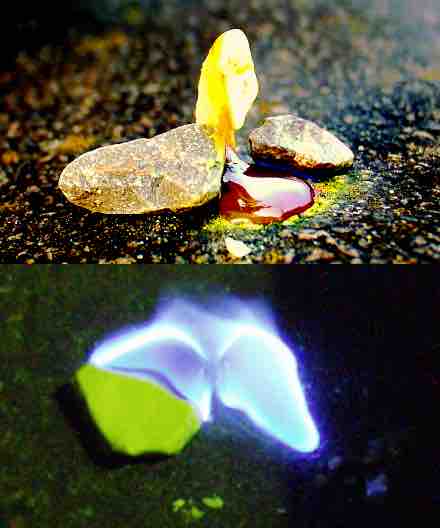Octasulfur
Sulfur is found is different polyatomic allotropic forms. The best-known allotrope is octasulfur, cyclo-S8. Octasulfur is a soft, bright-yellow solid with only a faint odor, similar to that of matches. It melts at 115.21 °C, boils at 444.6 °C, and sublimes easily.

Cyclooctasulfur
The structure of the cyclooctasulfur molecule, S8.
At 95.2 °C, below its melting temperature, cyclooctasulfur changes from α-octasulfur to the β-polymorph. The structure of the S8 ring is virtually unchanged by this phase change, which affects the intermolecular interactions. Between its melting and boiling temperatures, octasulfur changes its allotropic form again, turning from β-octasulfur to γ-sulfur. Again, this is accompanied by a lower density but increased viscosity due to the formation of polymers. At even higher temperatures, however, the viscosity decreases as depolymerization occurs. Molten sulfur assumes a dark red color above 200 °C. The density of sulfur is about 2 g/cm3, depending on the allotrope. All of sulfur's stable allotropes are excellent electrical insulators.
Chemical Properties of Sulfer
Sulfur burns with a blue flame, concomitant with formation of sulfur dioxide, notable for its peculiar suffocating odor. Sulfur is insoluble in water but soluble in carbon disulfide and, to a lesser extent, in other nonpolar organic solvents, such as benzene and toluene. The first and the second ionization energies of sulfur are 999.6 and 2252 kJ/mol, respectively. Despite such figures, S2+ is rare, with S+4 and S6+ being more common. The fourth and sixth ionization energies are 4556 and 8495.8 kJ/mol. The magnitude of the figures is caused by electron transfer between orbitals; these states are only stable with strong oxidants such as fluorine, oxygen, and chlorine.

Melting and burning sulfur
Sulfur burns with blue flames and forms blood-red liquid when it melts.